Bergbaumuseum Altenberg
Neubeschert-Glück-Stolln
Useful Information
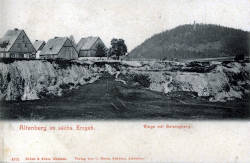
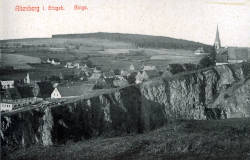
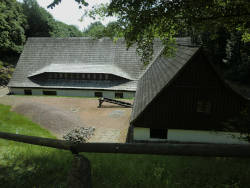
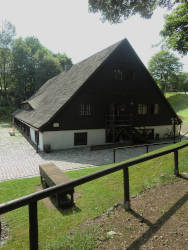
| Location: |
Mühlenstraße 2, 01773 Altenberg.
From Altenberg S178 towards Lauenberg, turn left on Mühlenstraße, parkin lot right.
Meeting point for Pingenführungen: Tourist-Info-Büro Altenberg. (50.763124, 13.768335) |
| Open: |
Museum: All year Mon-Thu, Sat, Sun, Hol 10-16. Pingenführungen (guided tours of the pits): Wed, Sun 10:30. Show mine: All year Mon-Thu, Sat, Sun, Fri 10:30, 12, 13:30, 15. [2021] |
| Fee: |
Museum: Adults EUR 4, Children (6-16) EUR 3, Children (0-5) free, Students EUR 3, Disabled EUR 3, Family (2+*) EUR 11. Groups (10+): Pupils EUR 2.50. Museum + show mine + tin washing: Adults EUR 7, Children (6-16) EUR 4, Children (0-5) free, Students EUR 4, Disabled EUR 4, Family (2+*) EUR 18. Groups (10+): Students EUR 3.50. Guided tours: Adults EUR 5, Children (6-16) EUR 3, Children (0-5) free, Students EUR 2.50, Disabled EUR 2.50. Groups (10+): Students EUR 2. [2021] |
| Classification: |
 Tin Mine Tin Mine
 Fire-setting Fire-setting
|
| Light: |
 Electric Light Electric Light
|
| Dimension: | T=8-10 °C, MinAge=4. |
| Guided tours: |
Schaustollen: D=1 h. Zinnwäsche: D=30 min. |
| Photography: | allowed |
| Accessibility: | no |
| Bibliography: | |
| Address: |
Bergbaumuseum Altenberg, Mühlenstraße 2, 01773 Altenberg, Tel: +49-35056-31703.
E-mail: |
| As far as we know this information was accurate when it was published (see years in brackets), but may have changed since then. Please check rates and details directly with the companies in question if you need more recent info. |
|
History
| ~1440 | start of mining after the discovery of an extensive tin ore deposit at the Alter Berg. |
| 1545 | due to lack of stability frequent collapse of single pits. |
| 1451 | Bergstadt Altenberg founded, punch mills and other infrastructure erected. |
| 1577 | first written mention of the tin wash and the owner at the time Hyronimus Naumann. |
| 1620 | Collapse destroys large parts of the Altenberg mine. |
| 1663 | Tin works become the property of the newly formed Zwitterstockgewerkschaft Altenberg. |
| 1793 | Pulverhaus (Explosives Storage) built. |
| 1802-1849 | Neubeschert-Glück-Stollen created. |
| 1951 | closure of the Pochwerk. |
| 1952 | closure of the Zinnerzwäsche. |
| 1953 | Zinnerzwäsche declared a Historic Monument. |
| 1953 | Show mine Heinrichsohle closed. |
| 1953-57 | Under the direction of the Saxon State Office for the Preservation of Historical Monuments, expanded into a technical show facility. |
| 1957 | Zinnerzwäsche passes into municipal ownership and is opened to the public. |
| 1971 | opening of the show mine Neubeschert-Glück-Stollen. |
| 1976 | exhibition "Pewter in Nature, History and Technology" set up in the attic of the Zinnerzwäsche. |
| 1983 | Zinnerzwäsche closed due to severe damage to building and historic furnishings caused by excessive wetness and wear. |
| 1990 | beginning of renovation with funds of the EU, the Federal Republik, the State and the city Altenberg. |
| 1991 | mine closed after the unification of East and West Germany. |
| 1994 | Zinnerzwäsche reopened after restoration. |
Geology
The Zwitterstock consists of granite criss-crossed by countless fine fissures. In these fissures, hot, pressurised vapours and solutions have caused Vergreisung (mineral transformation). The minerals topaz, lithium mica, quartz and tinstone were deposited in the fissures. Other accompanying minerals are fluorite, hematite, bismuth and arsenopyrite.
Zwitter (Hybrid) is, in German miner’s jargon, a tin ore formation in granite diapirs caused by greisen. In the 15th century, tin dioxide cassiterite (SnO2) was thought to be a hybrid of ore and rock. They have a low thickness. Larger deposits are called Zwitterstöcke or Zwitterstockwerke. Greisen are mostly grey rocks composed mainly of quartz, so named because of their colour reminiscent of grey hair, the German word Greis means an old man. The mining term was introduced into the petrological literature by Abraham Gottlob Werner in the 19th century. It became an international geological term and is also used in English.
Description
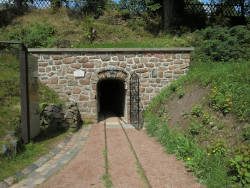
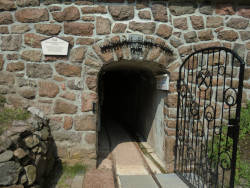
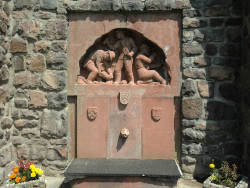
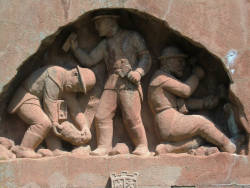
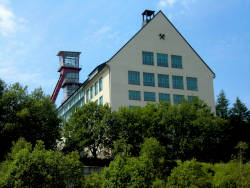
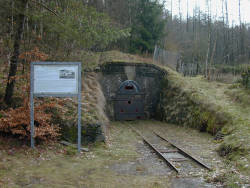
The Altenberg Pinge is a deep collapse crater where one of the most important tin deposits in Europe was mined for centuries. The traditional mining method was fire setting, where the ore was heated by a wood fire and then quenched with cold water. The heated ore lost water, sulphur and other volatile components, and was also shattered by the sudden cooling. It could then be easily mined with a pickaxe. In the beginning, mining was done on a family basis and without coordination. In the 16th century, it is said that at times over a hundred individual miners undermined the Altenberg Zwitterstock in this way. The result was predictable: there were several collapses and in 1620 there was the great Pingenbruch von Altenberg (Collapse of Altenberg). Several of the largest mines collapsed and a large crater formed, the Altenberg Pinge.
The collapse claimed human lives and destroyed various mines. Therefore the 30-year war which broke out shortly afterwards brought mining to an almost complete standstill for a long time. After the war, under pressure from the authorities, the individual mining companies were united to form the so-called Zwitterstocksgewerkschaft, a sort of Medieval mining cooperative. As a result, mining recovered. However, the most intensive mining from about 1976 onwards rapidly enlarged the Pinge, doubling its size in the 1970s and 1980s alone. Its current dimensions are about 400 m in diameter, 150 m deep and 12 ha in area. The large crater is pretty much equivalent in surface extent to the Zwitterstock.
The Altenberg Pinge is widely cordoned off by a high fence and cannot be seen by passing visitors. A viewing platform on the edge of Altenberg offers a unique view of the Pinge. However, this is not open to the public for safety reasons. In the summer months, Pingenwanderungen (pinge walks) are offered once a week. From the meeting point at the tourist information office at Altenberg railway station, you can see various remarkable monuments of Altenberg’s mining history on a 3 km circular route.
Until the early 1950s, the show mine Heinrichssohle could be reached via the pinge. However, this is no longer accessible today; massive mining afterwards destroyed the access.
The Mining Museum Altenberg is located only 200 m south-east of the pinge in the historic tin wash. Originally it was called Naumann Mill because in the first documentary mention of 1577 Hyronimus Naumann is named as the owner. When it became the property of the newly formed Zwitterstockgewerkschaft Altenberg in 1663, it was referred to as the IVth zwitterstockgewerkschaft laundry. The historic tin wash consists of a 40-stamp wooden punching mill, as already described for Altenberg by Georgius Agricola in 1556 in his book "De re metallica". It is a unique plant in Europe in terms of age, size and type. The ore delivered to the Poch mill was crushed into fine slurry in the wet-poch mill. With wooden ditches and on so-called hearths, wooden working surfaces, an ore concentrate was washed out with the help of water. During normal operation, the plant produced about 7 kg of tin ore concentrate per hour. The ore concentrate thus obtained was smelted into pure tin in smelters.
The mouth of the Neubeschert-Glück-Stolln, which has been operated as an exhibition mine since 1971, is also located on the site. Its excavation was begun in 1802 as an exploratory gallery, and mining ceased in 1849. The gallery was secured for 200 m and is now an exhibition of mining technology from more than five centuries in a realistic environment. Thus, Weitungsbau with the method of fire-setting is presented as well as modern Teilsohlenbruchbau mining. The area around the museum is used as an open-air exhibition for heavy machinery from the 20th century. Mine locomotives, mine cars, drilling rigs, flotation machines and a ball mill show the variety of equipment used. A lapidarium displays various stones such as mining district boundary stones, rubbing stones and the soles of historical poking mills. The museum is located on the 40 km long mining trail.
In neighbouring Zinnwald, people were "going for tin" as early as the 16th century. Later, tungsten ores and lithium mica were also mined. Freiberg was a stacking site for Altenberg tin, and the chief mining office exercised direct supervision over the Altenberg mine. In 1663, Balthasar Rösler was transferred from Freiberg to Altenberg as mining master and mine surveyor and also held the office of gallery factor.
The former mining facilities are also used for other purposes. For example, the headframe on the AL shaft was declared a Historic Monument in 1996 and renovated along with the surrounding buildings. Today, under the name EUROPARK Altenberg, premises for commercial, office and seminar use are rented out here. But accommodation, exhibition space, as well as sports and leisure facilities are also available.
 Search DuckDuckGo for "Bergbaumuseum Altenberg"
Search DuckDuckGo for "Bergbaumuseum Altenberg" Google Earth Placemark
Google Earth Placemark OpenStreetMap
OpenStreetMap Bergbaumuseum Altenberg, official website (visited: 08-FEB-2021)
Bergbaumuseum Altenberg, official website (visited: 08-FEB-2021) (visited: 08-FEB-2021)
(visited: 08-FEB-2021) Index
Index Topics
Topics Hierarchical
Hierarchical Countries
Countries Maps
Maps